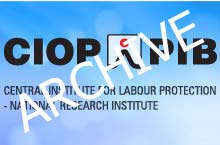|
|
INTERNATIONAL JOURNAL OF OCCUPATIONAL SAFETY AND ERGONOMICS
Volume 13 Number 4, 2007
|
CONTENTS:
Articles:
- Wavelet Transfer Function in the Analysis of the Influence of a Palm Grip on Actual Vibrations of an Upper Limb
Wojciech Batko & Robert Barański, 355-365 
- A Vibroacoustic Model of Selected Human Larynx Diseases
Zbigniew Witold Engel, Maciej Kłaczyński & Wiesław Wszołek, 367-379 
- A Power Transformer as a Source of Noise
Wiktor Marek Zawieska, 381-389 
- Central Auditory Damage Induced by Solvent Exposure
Adrian Fuente & Bradley McPherson, 391-397 
- Wrocław’s Motorway Ring-Road—Noise Protection
Barbara Rudno-Rudzińska, 399-408 
- Theoretical Predictions and Actual Hearing Threshold Levels in Workers Exposed to Ultrasonic Noise of Impulsive Character — A Pilot Study
Małgorzata Pawlaczyk-Łuszczyńska, Adam Dudarewicz & Mariola Śliwińska-Kowalska, 409-418 
- Noise Reduction of Spiral Ducts
Wojciech Łapka & Czesław Cempel, 419-426 
- Assessing the Acoustical Climate of Underground Stations
Elżbieta Nowicka, 427-431 
- Accuracy of Assessing the Level of Impulse Sound From Distant Sources
Tadeusz Wszołek & Maciej Kłaczyński, 433-440 
- Location of Noise Sources in Fluid Power Machines
Wiesław Fiebig, 441-450 
- Decision Support System for Designing Effective Noise Hazard Prevention Strategies
Krisada Asawarungsaengkul, Suebsak Nanthavanij & Junalux Chalidabhongse, 451-470 
|
 |
Wavelet Transfer Function in the Analysis of the Influence of a Palm Grip on Actual Vibrations of an Upper Limb
Wojciech Batko & Robert Barański
Algorithms used to determine the vibrations to which hand–tool operators are exposed take into account only vibrations measured on a tool. Thus, the significant influence of constraints joining the elements of the tool–operator system is neglected. This paper attempts to determine the influence of grip on vibrations recorded both on the tool and on the limb. The estimation was based on the use of the wavelet transfer function, in which the analysis was done by filtration with wavelet functions. Signals recorded with the specially designed system were utilised in investigations.
 |
A Vibroacoustic Model of Selected Human Larynx Diseases
Zbigniew Witold Engel, Maciej Kłaczyński & Wiesław Wszołek
With the present development of digital registration and methods for processing speech it is possible to make effective objective acoustic diagnostics for medical purposes. These methods are useful as all pathologies and diseases of the human vocal tract influence the quality of a patient’s speech signal. Diagnostics of the voice organ can be defined as an unambiguous recognition of the current condition of a specific voice source. Such recognition is based on an evaluation of essential acoustic parameters of the speech signal. This requires creating a vibroacoustic model of selected deformations of Polish speech in relation to specific human larynx diseases. An analysis of speech and parameter mapping in 29-dimensional space is reviewed in this study. Speech parameters were extracted in time, frequency and cepstral (quefrency) domains resulting in diagrams that qualified symptoms and conditions of selected human larynx diseases. The paper presents graphically selected human larynx diseases.
 |
A Power Transformer as a Source of Noise
Wiktor Marek Zawieska
This article presents selected results of analyses and simulations carried out as part of research performed at the Central Institute of Labor Protection – the National Research Institute (CIOP-PIB) in connection with the development of a system for active reduction of noise emitted by high power electricity transformers. This analysis covers the transformer as a source of noise as well as a mathematical description of the phenomenon of radiation of vibroacoustic energy through a transformer enclosure modeled as a vibrating rectangular plate. Also described is an acoustic model of the transformer in the form of an array of loudspeakers.
 |
Central Auditory Damage Induced by Solvent Exposure
Adrian Fuente & Bradley McPherson
Different studies have demonstrated that solvents may induce auditory damage. It has been suggested that part of this damage may be localised in central auditory pathways. The present study aimed to investigate possible auditory processing disorders related to solvent exposure. Thirty solvent-exposed workers and 30 gender-, age- and educational level-matched control subjects were selected to participate in the study. To select participants, a questionnaire, otoscopy, pure-tone audiometry and tympanometry were carried out. Filtered speech (FS), random gap detection (RGD) and hearing-in-noise tests (HINT) were conducted in the selected participants. Both groups of workers presented as a mean normal hearing thresholds. However, significant differences between groups were observed for RGD, FS and HINT. It is concluded that a possible auditory processing disorder may be related to solvent exposure.
 |
Wrocław’s Motorway Ring-Road—Noise Protection
Barbara Rudno-Rudzińska
The 35.4-km stretch of the A8 motorway, i.e., Wrocław’s motorway ring-road (WMRR), passes through the north-west part of the city of Wrocław and 4 neighbouring districts. Analyses have shown that WMRR will be a source of noise in the environment, which may adversely affect large areas. Normative environmental protection acts mandate taking all the necessary technical and organizational measures to reduce noise generated by the operation of WMRR in order to comply with the acoustic environment quality standards. The paper presents the research methodology adopted for assessing noise impact and designing acoustic barriers, and proposed designs of acoustic barriers which take into account the acoustic requirements, technical limitations, urban development, and architectural conditions.
 |
Theoretical Predictions and Actual Hearing Threshold Levels in Workers Exposed to Ultrasonic Noise of Impulsive Character — A Pilot Study
Małgorzata Pawlaczyk-Łuszczyńska, Adam Dudarewicz, Mariola Śliwińska-Kowalska
Results of standard pure-tone audiom etry (PTA) were collected from 25 workers, mainly females, aged 23–58 years, exposed for 2–13 years to ultrasonic noise emitted by ultrasonic welders. Hearing tests were completed by evaluation of exposure to ultrasonic noise. The subjects’ actual audiometric hearing threshold levels (HTLs) were compared with theoretical predictions calculated according to ISO 1999:1990. In 60% of cases sound pressure levels in the 10–40 kHz 1/3-octave bands at workstands exceeded Polish exposure limits for ultrasonic noise. Our comparison of predicted and measured HTLs suggests that the ISO 1999:1990 method, intended for audible noise, might also make it possible to predict reliably permanent hearing loss (in the 2 000–6 000 Hz frequency range) after exposure to ultrasonic noise. No significant progress of hearing impairment (assessed using PTA) in the operators of ultrasonic welders was noted. Nevertheless, further studies on the hearing status of workers exposed to ultrasonic noise are needed.
 |
Noise Reduction of Spiral Ducts
Wojciech Łapka & Czesław Cempel
Institute of Applied Mechanics, Poznań University of Technology, Poznań, Poland The paper presents noise reduction (NR) of spiral ducts as a result of computational modeling of acoustic wave propagation. Three-dimensional models were created with the finite element method in COMSOL Multiphysics version 3.3. Nine models of spiral ducts with 1–9 spiral leads were considered. Time-harmonic analysis was used to predict NR, which was shown in spectral and interval frequency bands. Spiral duct performance can be seen as a comparison of NR before and after a change from a circular to a spiral duct.
 |
Assessing the Acoustical Climate of Underground Stations
Elżbieta Nowicka
Designing a proper acoustical environment—indispensable to speech recognition—in long enclosures is difficult. Although there is some literature on the acoustical conditions in underground stations, there is still little information about methods that make estimation of correct reverberation conditions possible. This paper discusses the assessment of the reverberation conditions of underground stations. A comparison of the measurements of reverberation time in Warsaw’s underground stations with calculated data proves there are divergences between measured and calculated early decay time values, especially for long source–receiver distances. Rapid speech transmission index values for measured stations are also presented.
 |
Accuracy of Assessing the Level of Impulse Sound From Distant Sources
Tadeusz Wszołek & Maciej Kłaczyński
Impulse sound events are characterised by ultra high pressures and low frequencies. Lower frequency sounds are generally less attenuated over a given distance in the atmosphere than higher frequencies. Thus, impulse sounds can be heard over greater distances and will be more affected by the environment. To calculate a longterm average immission level it is necessary to apply weighting factors like the probability of the occurrence of each weather condition during the relevant time period. This means that when measuring impulse noise at a long distance it is necessary to follow environmental parameters in many points along the way sound travels and also to have a database of sound transfer functions in the long term. The paper analyses the uncertainty of immission measurement results of impulse sound from cladding and destroying explosive materials. The influence of environmental conditions on the way sound travels is the focus of this paper.
 |
Location of Noise Sources in Fluid Power Machines
Wiesław Fiebig
This paper discusses noise generation mechanisms and techniques for noise reduction in fluid power units. Major noise sources in fluid power units can be identified with a sound intensity method. It has been proved that components of power units with larger sound radiating surfaces such as an electric motor and an oil reservoir produce a major part of global noise radiation.
 |
Decision Support System for Designing Effective Noise Hazard Prevention Strategies
Krisada Asawarungsaengkul, Suebsak Nanthavanij, Junalux Chalidabhongse
A decision support system for designing effective noise hazard prevention (NHP) strategies is proposed. NHP consists of four modules: (a) database, (b) input, (c) algorithms, and (d) solution. The user can choose among single-, two-, and three-approach solution procedures. Heuristic and genetic algorithms are used to determine appropriate noise controls (NCs). From the given noise condition and NC budget, NHP recommends a minimum-cost NHP strategy that prevents any worker’s daily noise exposure from exceeding the permissible level. If the budget is insufficient, NHP is able to search for a feasible noise hazard strategy that requires a minimum NC budget.
|
|








